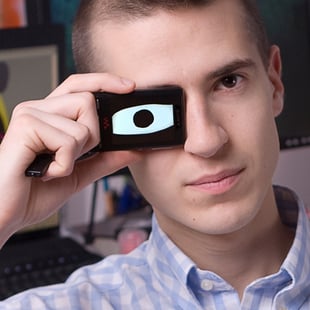Back
1. Animafest: Are there some constants, continuities in your work, some stylistic or narrative signatures, guidelines which you kept from your first films, through student and thesis movies, up to professional ones? Is there some sort of leitmotiv, of your special mark, something that goes beyond techniques and subjects?
Roberto Catani: My few works are very intimate and personal. If there is a constant in my films, I believe this is in the continuous introspective research. The formal and technical aspects are essential in the creation of the film, but they are adapted to the themes and emotions narrated in the films.
Špela Čadež: When I start planning a film I plan the story very widely. Though somehow in the end I’ve always ended up with related topics – love and loneliness. The story in my opinion “has to hold water”, the story for me goes beyond the technique. So most of all I try to use the media to support the story. I like the surreal moments that can be used only in the wonderful medium of animated film.
Tomek Ducki: There is one ingredient to be found in each of them: I always pick a structural style for movements, they can be based on dances (My Turn), sports (Life Line = figure skating, Baths = breaststroke swimming) or type of animal or human behaviours (Silent Touch = partly paralyzed people). I guess, there is also a minimalistic and functional approach in design, like I pick my colours and style very conceptually and I try to use the least elements needed. This very practical too: my brain doesn't explode during the work and I can concentrate on the final message. This might also come from the fact that used to be a logo and poster designer.
2. Animafest: Which aspects of human nature on the one hand, and which artistic influences on the other, have been most relevant for your work?
Roberto Catani: The themes of childhood and solitude are very interesting to me and they strongly stimulate my imagination. I think that these two aspects of human existence play a central role in my work. But it is also constantly contaminated - every work of art, every person or experience changes my way of seeing the world. When I was young Jurij Norstejn’s films had a strong influence on me, but then I was influenced by a lot of artistic and human experiences. Mattotti’s colours, drawings by Feuchtenberger, Goblet, Carriò and Londoño were very important to me, so as many books or films that I have seen. In the same way, the dynamics of everyday life in all its aspects, human relationships, affections, disappointments (in a word, life) have been fundamental for my work.
Špela Čadež: Human relationships are the most fascinating for me as a subject. More than artworks I believe my work is influenced by daily life.
Tomek Ducki: The simplest thing which I can say is that I like the process of how human brain interpreting every movement as something meaningful and anthropomorphic, even if it`s only a waving branch in the air. In our mind it can become very complex, creating even social and political issues.
3. Animafest: In what aspect did creative process you went through for your last movie differ from the ones for your past films and will it change in the future?
Roberto Catani: My past films were built on the evocative and symbolic force of single images, without a traditional narrative structure. In my last movie instead the story prevails over images. I tried to tell rather than suggest. Absent Minded is a totally autobiographical work, so it is the one in which I most invested emotionally. I don’t know if artistically and cinematographically it is the most interesting of my works, but I know that it has been the most demanding and difficult one, because the themes it deals with are very painful to me.
Špela Čadež: My latest film Boles is based on literature. Conceptualizing the story and writing the screenplay from a short story was a different process than creating a full new story. In a way having a given basis is easier, but it is far from an easy task. I am currently working on a new short animated film. I will be using a slightly different technique, a Multiplan cut out animation.
Tomek Ducki: It is always the same, like digging in the ground for water. I go around the field with a branch in my hands and waiting so that at some point it will react over a special spot to start the well. Then I dig down in the hope that after a while I finally find the water. I am under the impression that it is about 90% of digging and only a 10% of what you finally see in the film. I am doing at the moment involved in an experiment to find a common space of farming and animation. I still haven't managed to teach the chickens for inbetween animation, but I have already found a step in the lifecycle of the wood to use for animation between its chopped and used for heating.



